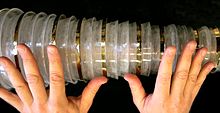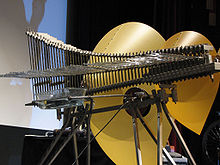| This article relies largely or entirely on a single source. Relevant discussion may be found on the talk page. Please help improve this article by introducing citations to additional sources. Find sources: "Crystallophone" – news · newspapers · books · scholar · JSTOR (April 2021) |



A crystallophone is a musical instrument that produces sound from glass.
One of the best known crystallophones is the glass harmonica, a set of rotating glass bowls which produce eerie, clear tones when rubbed with a wet finger. Musical glasses, the glass harp, were documented in Persia in the 14th century. The "ethereal" quality of instruments such as the glass harmonica exemplified the Empfindsamkeit and for a while, "the instrument was extraordinarily popular... About 1830 the instrument fell into oblivion."
The glasschord (or glasscord) resembles the celesta (a struck plaque idiophone operated by a keyboard) but uses keyboard-driven hammers to strike glass bars instead of metal bars.
The glass marimba is similar to the marimba (a stick percussion instrument with a keyboard layout), but has bars of glass instead of wood. The bars, which the performer strikes with padded sticks, are perched on a glass box to provide the necessary resonance.
A rare Thai instrument called ranat kaeo (ระนาดแก้ว; literally "glass xylophone") has been used by the Thai music ensemble Fong Naam; it appears on their 1992 CD The Sleeping Angel: Thai Classical Music.
In popular culture
In Lydia Syson's biography, Doctor of Love: James Graham and his Celestial Bed, sexologist James Graham uses the glass harmonica for musical therapy purposes.
Benjamin Franklin was inspired to create his glass harmonica in 1763 after attending a recital performed on musical glasses in London in 1761.
See also
References
- ^ Apel, Willi (1969). Harvard Dictionary of Music, p.347. Harvard. ISBN 9780674375017.
- Syson, Lydia. Doctor of Love: James Graham and his Celestial Bed. ISBN 9781846880544.
External links
- Glass music
- Oddmusic - a website dedicated to unique, odd, ethnic, experimental and unusual musical instruments and resources.
| Crystallophone (glass instruments) | |
|---|---|
This glass-related article is a stub. You can help Misplaced Pages by expanding it. |
This article relating to percussion instruments is a stub. You can help Misplaced Pages by expanding it. |